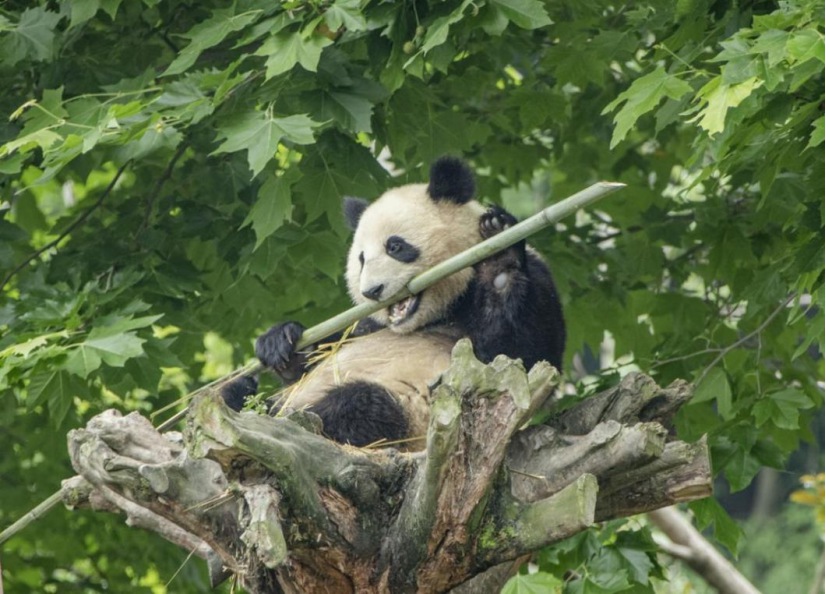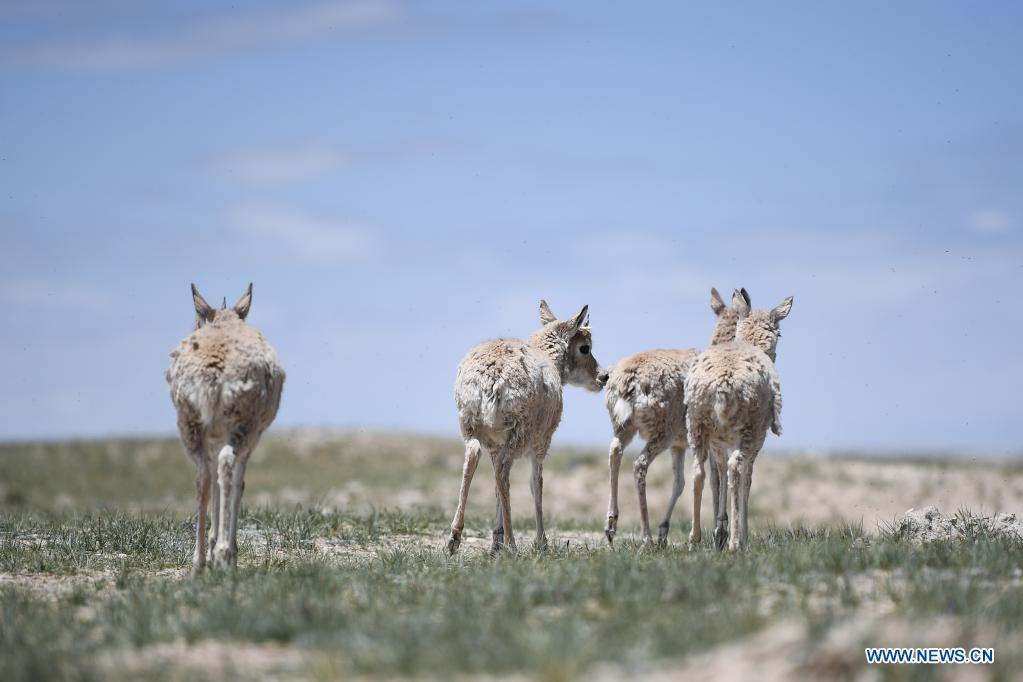Giant Pandas no longer endangered, signaling China's success in biodiversity protection

A giant panda eats bamboo at Shenshuping base of China Conservation and Research Center for the Giant Panda in Gengda township, Wenchuan county, Ngawa Tibetan and Qiang autonomous prefecture, southwest China's Sichuan province, June 24, 2021. (People's Daily Online/Liu Guoxing)
Conservation efforts in China have paid off. The giant pandas in China has been downgraded from "endangered" to "vulnerable", as the number of this species in the wild has exceeded 1,800 after years of biodiversity protection and ecological restoration, according to Cui Shuhong, director of the Department of Natural Ecological Protection of the Ministry of Ecology and Environment, at a press conference on July 7, 2021.
The decision came five years after the International Union for Conservation of Nature (IUCN) removed giant pandas from its endangered species list and classified them as vulnerable on September 2016.
The global community has acknowledged China's effort in pulling the giant panda back from the brink. The World Wildlife Fund (WWF) praised it as "another sign of hope for the species". Colby Loucks, WWF's Vice President for Wildlife Conservation said in a statement on July 9 that "China's successful conservation of giant pandas shows what can be achieved when political will and science join forces."
The announcement was also met with delight on social media, with the relative hashtags on Weibo, a microblogging platform has been read up to 130 million times. Most of them hailed it as a proof of China's success in biodiversity protection.
"Wonderful news! This is the results of years of hard work. Well done to all the conservationists," one netizens commented on Weibo.
"This is great news. We are glad to see one great story after another in China's ecology conservation efforts," said Wang Wenbing, the Chinese Foreign Ministry Spokesperson at a press conference on July 8, 2021.

Tibetan antelopes are released into the wild at a wildlife rescue center of the Sonam Dargye Protection Station in Hoh Xil, northwest China's Qinghai Province, July 7, 2021. (Xinhua/Zhang Long)
"The giant panda epitomizes China's national effort on protecting endangered species," said Cheng Rong, staff from Chengdu Research Base of Giant Panda Breeding. Indeed, the Giant panda was among those rare and endangered species in China that are on the road to recovery. In the past decades, the population of Tibetan antelope, which were on the verge of extinction in the 1980s, has increased four times from 50,000 to 200,000, and the species was re-classified as "near-threatened"; Milu Deer, once endangered in China due to overhunting and habitat loss, also saw the surge in its population. As of November 2020, the total population of the species has surpassed 8,000.
The numbers of other rare and endangered species such as Siberian tigers, Asian elephants and crested ibises have snowballed, and these species have been sighted more frequent by people. Chinese dessert cats, which are rare and sparse and have hardly trailed over the years, were captured by cameras in the Qilian Mountain National Park in March. Another mysterious species, rufous necked hornbills, which haven't been spotted for decades, were found in mountain forests more than 2,000 meters above sea level in Yingjiang county, Dehong Dai and Jinpo Autonomous Prefecture of Yunnan Province.
"The reclassification and other phenomena reflect China's achievement on preserving biodiversity and restoring ecology," said Cui Shuhong at the press conference.
"The improvement in the living conditions of China's wildlife can be attributed to the country's drive in establishing a relatively complete system of nature reserves, which protect large areas of natural ecosystems systematically and completely," said Cui.
China has drafted and adopted the National Biodiversity Conservation Strategy and Action Plan (2011-2030), which serves as a guide to the national mid-and the long-term biodiversity protection. As an essential part of ecological civilization, biodiversity conservation has been sprinkled through both central and regional policy-making processes.

Photo shows a Chinese desert cat, a wild animal under Grade-I conservation in China. The Photo is captured in the Qilian Mountain National Park in northwest China’s Qinghai province. (Photo by Song Dazhao)
Protecting the habitats of the wildlife is the key solution to get the rare species out of the woods. As of July 2021, the forest coverage rate in China has risen to 23.04 percent, covering 220 million hectares. The figure also doubled from 12.7 percent in the 1970s. China has formed an ecological red line system that at least 25 percent of China's land area shall be demarcated for ecological protection. By the end of 2019, China had 11,800 nature reserves of various types, covering more than 170 million hectares, or 18% of China's land areas, which meet the Aichi Biodiversity Targets goal of protecting 17 percent of terrestrial areas ahead of schedule. China also set up botanical gardens and wildlife breeding bases to breed rare and endangered species.
Apart from improving natural habitats, China has implemented different measures to protect the wild species. The supervision and law enforcement on crimes related to wild animals were enhanced.
From releasing the rare Siberian tiger back into the wild in northeast China's Heilongjiang Province to saving the wandering elephants in southwest Yunnan Province, protecting wildlife was sprawling into daily life, with the government's support and public participation. A cooperative rescue of stranded melon-headed whales is the most recent Chinese joint effort on biodiversity protection, which won the thump-up from home and abroad.
"A quality of a nation is judged by the manner it treats its weakest members," one netizens commented under the video of melon-headed whales rescue mission.
Despite the improving living conditions of the wildlife, China's protection of biodiversity will not be weakened. Looking ahead, the country will build a comprehensive monitoring system for biodiversity conservation, enhance international cooperation and promote public participation, said Cui.
Photos
Related Stories
- Commentary: China's welcome panda news a success but not full stop of biodiversity efforts
- China makes notable progress on biodiversity conservation: official
- Chinese experience in desert control helps green the world
- China vigorously promotes protection of marine biodiversity
- China marks World Oceans Day with a focus on protecting marine biodiversity
Copyright © 2021 People's Daily Online. All Rights Reserved.










